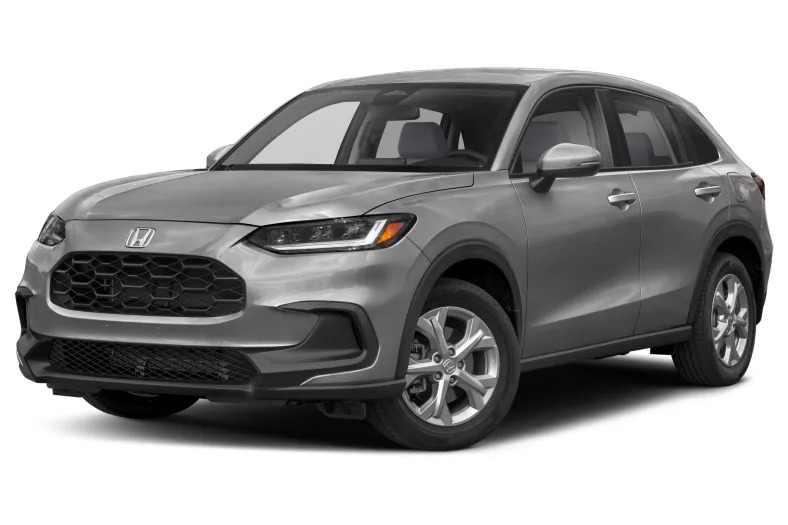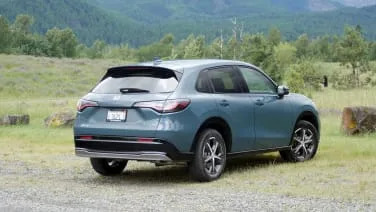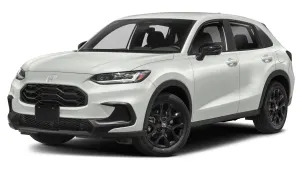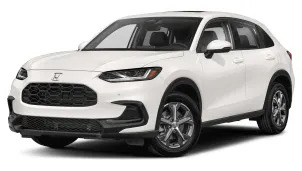2024 Honda HR-V
Industry
Pros: High-end cabin; it’s basically a big Civic; top safety scores; Honda dependability and resale Cons: Slow, even by segment standards, without a fuel economy bonus; no sporty or outdoorsy trim levels The 2024 Honda HR-V is apparently the best-selling SUV in the United States for first-time car buyers as well as those belonging to Gen Z (one would assume there’s an awful lot of overlap there). Credit to those buyers, then, as they are certainly making a sensible purchase. The HR-V has a big, well-made cabin, plenty of space, top safety scores and carries Honda’s well-earned reputation for reliability and resale. As simple, dependable transportation for those wanting to sit up a bit higher and enjoy some versatility, the HR-V gets the job done. It feels like there’s a “but” coming here, doesn’t it? There is! While the HR-V is certainly sensible, it is also awfully dull. Other subcompact SUVs offer distinctive style and cater to certain niches with sporty or off-road-flavored variants. In short, they have more character. Then, with rare exception, they are more engaging to drive and have stronger engines. The HR-V is one of the slowest cars out there and it absolutely feels it. Worse, it doesn’t counteract that with above-average fuel economy. Even its utility is mid-pack – the cargo area isn’t as spacious as its cargo volume suggests and there are no roof rails available to expand its versatility. Basically, the HR-V may be a sensible choice, but it’s otherwise just fine. We would sooner recommend others in the segment, some of which cost less money while delivering more. That includes the Chevrolet Trax, Buick Envista, Kia Seltos, Subaru Crosstrek, Kia Niro hybrid, Hyundai Kona, Volkswagen Taos, Mazda CX-30 and super-budget-friendly Nissan Kicks. Yes, it’s a long list, but that speaks to where the HR-V sits in the pecking order. Interior & Technology | Passenger & Cargo Space | Performance & Fuel Economy What it's like to drive | Pricing & Trim Levels | Crash Ratings & Safety Features What's new for 2024? The HR-V carries over unchanged for 2024. What are the HR-V interior and in-car technology like? Apart from the high, floating center console lined in soft-touch pleather that makes its way from the last HR-V (albeit updated), the rest of the cabin’s handsome design and above-average materials are largely in keeping with the Honda Civic. That’s a great thing. The most obvious Civic cue is the wheel-to-door air vent plated by a metal-look honeycomb pattern. There may come a day when Honda overuses this design element but, for now, it’s exceptional. You can read our deep dive review of the HR-V EX-L trim level here. The touchscreen (7 inches in LX and Sport, 9 inches in EX-L), are shared with the Civic, and are exponentially better than the outgoing HR-V’s slow, convoluted and just-plain-old touchscreen. Now, are those screens better than those of the HR-V’s rivals? No, not really, especially when compared to the Kia Seltos and Chevy Trax/Buick Envista twins. They’re …
Full Review
Pros: High-end cabin; it’s basically a big Civic; top safety scores; Honda dependability and resale Cons: Slow, even by segment standards, without a fuel economy bonus; no sporty or outdoorsy trim levels The 2024 Honda HR-V is apparently the best-selling SUV in the United States for first-time car buyers as well as those belonging to Gen Z (one would assume there’s an awful lot of overlap there). Credit to those buyers, then, as they are certainly making a sensible purchase. The HR-V has a big, well-made cabin, plenty of space, top safety scores and carries Honda’s well-earned reputation for reliability and resale. As simple, dependable transportation for those wanting to sit up a bit higher and enjoy some versatility, the HR-V gets the job done. It feels like there’s a “but” coming here, doesn’t it? There is! While the HR-V is certainly sensible, it is also awfully dull. Other subcompact SUVs offer distinctive style and cater to certain niches with sporty or off-road-flavored variants. In short, they have more character. Then, with rare exception, they are more engaging to drive and have stronger engines. The HR-V is one of the slowest cars out there and it absolutely feels it. Worse, it doesn’t counteract that with above-average fuel economy. Even its utility is mid-pack – the cargo area isn’t as spacious as its cargo volume suggests and there are no roof rails available to expand its versatility. Basically, the HR-V may be a sensible choice, but it’s otherwise just fine. We would sooner recommend others in the segment, some of which cost less money while delivering more. That includes the Chevrolet Trax, Buick Envista, Kia Seltos, Subaru Crosstrek, Kia Niro hybrid, Hyundai Kona, Volkswagen Taos, Mazda CX-30 and super-budget-friendly Nissan Kicks. Yes, it’s a long list, but that speaks to where the HR-V sits in the pecking order. Interior & Technology | Passenger & Cargo Space | Performance & Fuel Economy What it's like to drive | Pricing & Trim Levels | Crash Ratings & Safety Features What's new for 2024? The HR-V carries over unchanged for 2024. What are the HR-V interior and in-car technology like? Apart from the high, floating center console lined in soft-touch pleather that makes its way from the last HR-V (albeit updated), the rest of the cabin’s handsome design and above-average materials are largely in keeping with the Honda Civic. That’s a great thing. The most obvious Civic cue is the wheel-to-door air vent plated by a metal-look honeycomb pattern. There may come a day when Honda overuses this design element but, for now, it’s exceptional. You can read our deep dive review of the HR-V EX-L trim level here. The touchscreen (7 inches in LX and Sport, 9 inches in EX-L), are shared with the Civic, and are exponentially better than the outgoing HR-V’s slow, convoluted and just-plain-old touchscreen. Now, are those screens better than those of the HR-V’s rivals? No, not really, especially when compared to the Kia Seltos and Chevy Trax/Buick Envista twins. They’re …
Hide Full Review
Hide Full Review
Retail Price
$24,600 - $30,200
MSRP / Window Sticker Price
| Engine | 2.0L I-4 |
| MPG | Up to 26 city / 32 highway |
| Seating | 5 Passengers |
| Transmission | 2-spd CVT w/OD |
| Power | 158 @ 6500 rpm |
| Drivetrain | all wheel, front-wheel |
| Curb Weight | 3,159 - 3,333 lbs |
Smart Buy Program is powered by 







